Artist References
“Augmented Reality for Bad Days” by Maddy Varner and Lauren McCarthy (2015)
Using google cardboard, “Augmented Reality for Bad Days” allows you to experience an alternate space which becomes a counterbalance to your mood or the quality of your day. By inserting and adding contextual content to a sampled environment, this google
“Augmented Reality for Bad Days” by Maddy Varner and Lauren McCarthy (2015)
Using google cardboard, “Augmented Reality for Bad Days” allows you to experience an alternate space which becomes a counterbalance to your mood or the quality of your day. By inserting and adding contextual content to a sampled environment, this google
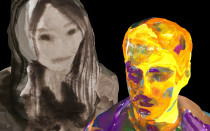
“Skin Deep” by Rosalie Yu and Alon Chitayat (2015)
Viewers are invited to paint over 3D-scanned likenesses of the artists to create “collaborative self-portraits.”

“Skin Deep” by Rosalie Yu and Alon Chitayat (2015)
Viewers are invited to paint over 3D-scanned likenesses of the artists to create “collaborative self-portraits.”

Dolorean’s “Crystal” by Joan Guasch (2015)
A music video directed by Joan Guasch for “Crystal” by Dolorean, in which 3D-scanned busts vomit amorphous crystalline forms.

Dolorean’s “Crystal” by Joan Guasch (2015)
A music video directed by Joan Guasch for “Crystal” by Dolorean, in which 3D-scanned busts vomit amorphous crystalline forms.
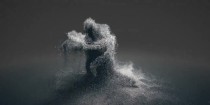
“unnamed soundsculpture” by Daniel Franke & Cedric Kiefer (2012)
A dance piece captured using three Kinects and assembled into a volume of 22,000 points.

“unnamed soundsculpture” by Daniel Franke & Cedric Kiefer (2012)
A dance piece captured using three Kinects and assembled into a volume of 22,000 points.
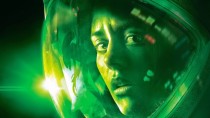
“Alien: Isolation” promo by Ten24 (2014)
Ten24’s promo for the video game Alien: Isolation. The hi-res character models were created using Ten24’s 140-camera capture system.

“Alien: Isolation” promo by Ten24 (2014)
Ten24’s promo for the video game Alien: Isolation. The hi-res character models were created using Ten24’s 140-camera capture system.
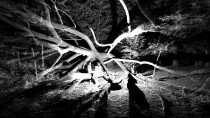
Ibeyi’s “Oya” by ScanLab Projects (2015)
ScanLab Projects’ music video for Ibeyi’s song “Oya” features ghostly renderings of a forested landscape created using an architectural laser scanner.

Ibeyi’s “Oya” by ScanLab Projects (2015)
ScanLab Projects’ music video for Ibeyi’s song “Oya” features ghostly renderings of a forested landscape created using an architectural laser scanner.
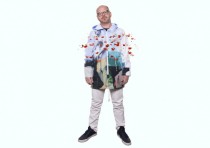
“PartsPartsParts (AR Shirts)” by Miles Peyton
“Miles Peyton brings his already-praised project PartsPartsParts into a new dimension by translating a website into a clothing item. The Pittsburgh-based artist’s webpage of the same name features small cut-out photos of anonymous body parts, which visitors can move around their screens.”

“PartsPartsParts (AR Shirts)” by Miles Peyton
“Miles Peyton brings his already-praised project PartsPartsParts into a new dimension by translating a website into a clothing item. The Pittsburgh-based artist’s webpage of the same name features small cut-out photos of anonymous body parts, which visitors can move around their screens.”

“Augmented Hand Series” by Golan Levin, Chris Sugrue, and Kyle McDonald
“…a real-time interactive software system that presents playful, dreamlike, and uncanny transformations of its visitors’ hands. It consists of a box into which the visitor inserts their hand, and a screen which displays their ‘reimagined’ hand—for example, with an extra finger, or with fingers that move autonomously.”

“Augmented Hand Series” by Golan Levin, Chris Sugrue, and Kyle McDonald
“…a real-time interactive software system that presents playful, dreamlike, and uncanny transformations of its visitors’ hands. It consists of a box into which the visitor inserts their hand, and a screen which displays their ‘reimagined’ hand—for example, with an extra finger, or with fingers that move autonomously.”
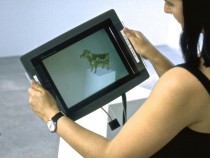
“The Golden Calf” by Jeffrey Shaw (1994)
“This work is constituted by a white pedestal on which there stands an LCD colour monitor connected to computing machinery by a cable running through the pedestal. The viewer of this work picks up and holds this monitor in his hands. The screen shows a representation of the pedestal with a computer-generated image of a golden calf on top. By moving the monitor around the actual pedestal the viewer can examine this golden calf from above and below and all sides. Thus the monitor functions like a window that reveals a virtual body apparently located physically in the real space.”

“The Golden Calf” by Jeffrey Shaw (1994)
“This work is constituted by a white pedestal on which there stands an LCD colour monitor connected to computing machinery by a cable running through the pedestal. The viewer of this work picks up and holds this monitor in his hands. The screen shows a representation of the pedestal with a computer-generated image of a golden calf on top. By moving the monitor around the actual pedestal the viewer can examine this golden calf from above and below and all sides. Thus the monitor functions like a window that reveals a virtual body apparently located physically in the real space.”

“Eyetap” by Steve Mann (1999)
“Steve Mann, a pioneer of wearable computers and a professor at the University of Toronto who had worn “a computer vision system of some kind for 34 years,”

“Eyetap” by Steve Mann (1999)
“Steve Mann, a pioneer of wearable computers and a professor at the University of Toronto who had worn “a computer vision system of some kind for 34 years,”
